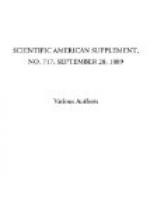The specimens should first be deprived of moisture, that is to say, they should be allowed to remain eight or ten days in succession in 50 per cent. alcohol and in pure commercial alcohol. Absolute alcohol is not necessary.
After being taken from the alcohol, and allowed to drain, the specimens are immersed in a mixture compound of
Pure glycerine 2 volumes,
Pure carbolic acid in crystals 1 volume.
In this they ought to remain at least a week, but there will be no harm if they are left therein indefinitely, so that the collections of summer may be mounted during winter evenings.
What follows is a little more delicate, although very easy. After being removed from the carbolated glycerine, the spiders are placed upon several folds of white filtering paper, and are changed from time to time until the greatest part of the liquid has been absorbed. An insect pin is then passed through the cephalothorax of each individual and is inserted in the support upon which the final desiccation is to take place. This support consists of a piece of sheet cork tacked or glued at the edges to a piece of wood at least one inch in thickness. Upon the cork are placed four or five folds of filtering paper, so that the ventral surface of the pinned spider is in contact with this absorbing surface. For the rest, the legs, palpi, spinnerets, etc., are spread out by means of fine pins, precisely as would be done in the case of coleoptera.
[Illustration: SETTING BOARD FOR SPIDERS.
A. Absorbent papers. B. Sheet cork. C. Wooden support.]
The setting board is put for two or three months in a very dry place under cover from dust.
The spiders thus treated will scarcely have changed in appearance, the abdomen of the largest Epeiras will have preserved its form, the hairs will in nowise have become agglutinated, and a person would never suspect that glycerine had performed the role.
The forms with a large abdomen require a special precaution; it is necessary to pass the mounting pin through a piece of thin cardboard or of gelatine prolonged behind under the abdomen, because the latter is heavy, and the pedicel that connects it with the cephalothorax easily breaks.
The specimens are mounted in boxes lined with cork, just as insects are.
As there is nothing simpler than to have in one’s laboratory three bottles, two of them containing alcohol and the other containing carbolated glycerine, and as it is easy to make setting boards capable of holding from twenty to thirty individuals at once, it will be seen that, with a little practice, the method is scarcely any more complicated than the one daily employed for coleoptera and orthoptera, which latter, too, must pass through alcohol, and be pinned, spread out, and dried. There are but two additional elements, carbolated glycerine and absorbent paper. I do not estimate the time necessary for desiccation as being very long, since the zoologist can occupy himself with other subjects while the specimens are drying. Let us add that the process renders the preservation indefinite, and that destructive insects are not to be feared. Some vertebrates, such as monkeys, that I preserved in the flesh ten years ago, by a nearly identical method, are still intact.—F. Plateau, in Le Naturaliste.




